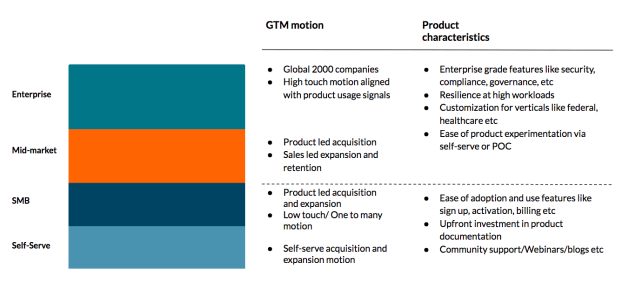In this guest post, Hazel Raoult delves into the key differences for product managers working in enterprise businesses.
Product management in an enterprise involves internal and external stakeholders who participate in iterative and innovative processes.
Understanding the target audience is inevitable if you are a product enterprise looking to widen the product reach and measure the product-market fit. Therefore, enterprise product management often involves a tailored sales approach that requires the team to step inside users’ shoes while creating new products. Ideally, it involves designing and driving the product roadmap — something that’s essential to create value for customers and users (both being different, to be discussed later).
That said, there are many aspects that differentiate product management in an enterprise from the consumer one.
Let’s find them out in detail.
The business model
The primary difference between consumer and enterprise products is the business model on which they function uniquely.
There are several revenue models for consumer technology, including advertising-supported, two-sided marketplaces, affiliate models, and direct sales (mainly self-service ones). Such ease of accessible market presence renders consumer products in an inherently scalable industry. It has a vast market to capture but a limited user base (due to high competition) that can influence crucial technological choices on the product, price, infrastructure, etc.
On the other hand, the only way to sell enterprise products is through a direct sales model. While this is one aspect of taking control over the sales process, the enterprise that is hugely involved in selling licenses or subscriptions like SaaS may need a sophisticated solution like CPQ software to simplify the pricing and quoting process.
Enterprise products are challenging to scale because they need to make direct sales to a few skilled and aware customers (compared to consumer software), which involves hefty payments. For this, tools like CPQ software can come in handy in creating fast and accurate price quotes for complex deals.
These conversions may take several weeks, months, or even years to plan, implement, track and negotiate. Even a low-cost B2B sales cycle could take around three months to close the deal. The sales process is intricate, making it difficult for startups to compete with enterprises and break into this industry.
This is partly because enterprise products differ from consumer products since the former is crafted for a specific business, its purpose, and its users.
More on it below…
Product specialization
Enterprise products are developed to meet specific technology or business needs. Examples include business analytics, CRM software, data administration, etc. The growing complexity of business demands a tailored solution that helps overcome day-to-day challenges.
The basics include identifying how users work, what their jobs are, bottlenecks they face, etc. Accordingly, enterprise software identifies how its products fit into the lives of enterprise professionals. Ideally, these enterprise products aim to deliver more business value over time by (scaling up) adding new features, capabilities, integrations, etc.
This holds true if your product grows from a specific solution (accounting software) that fills up a unique business need to serve a wider range of business operations (taxation and automated auditing) applicable across the industry.
Apart from product specialization, enterprise product management differs in terms of the target audience — customers vs. users.
Here’s how!
Customers vs. Users
First, begin with answering a key question — who are you building for? Customers or users?
Users are equipped with your product and invest their time and skills to drive the best results, but they are not buyers. The buyers are their bosses, top management personnel, and the organizations who pay for the software.
Ultimately, customers will have different priorities than the employees using enterprise products.
For instance, customers won’t dwell much on the UI and feature list (which is highly important for users). Instead, they prefer to know about the improved bottom line and high return on investment (ROI).
Often, users can influence executive customers and decision-makers by demanding certain features or solutions. Based on this, executives may shortlist solution suppliers with their department's advice or choose a known vendor's product. This holds true when the items are complex and need training or experience.
Therefore, enterprise project management requires a clear grasp of the end-user and customers while identifying how their rapport can influence buying decisions.
The selling process involves understanding the difference between users and consumers. This shows the nuanced nature of the issues a product management team has to tackle.
Time to dig in more.
Key nuances
Product management in an enterprise setting is a complex, multi-step process. Sales, pre-sales, customer success, and support become part of communication lifecycles dealing with different users. Therefore, considering the following key nuances is a must.
Balancing long-term product direction with quick, iterative delivery
If your product's long-term trajectory isn't clear, you may find it difficult to adapt to the market demands. Chances are, you may commit your team to work on a half-baked approach that isn't in line with your product's long-term goals. This scenario is very common with enterprise products.
Therefore, start by creating a flexible culture regarding the specifics of the long-term plan, and make it clear to both customers and internal stakeholders. One of the key nuances of enterprise product management is keeping your long-term goal directional (within the growth roadmap) but the short-term plans more concise and actionable.
Ideally, involve sales, customers, relationship management, technology, design, marketing, and operation teams to set short-term goals. For starters, indulge your team in storytelling that helps convey strategic intent over the long run.
Balancing the needs of the target audience
Enterprise product management requires identifying sources of customer dissatisfaction (pain points, typical challenges, etc.) and capitalizing on them to achieve a specific objective. Here, your enterprise may look beyond the preferences of the most valuable customers and prospects by considering the competitive landscape, the policy climate, and any impending compliance (HIPAA, SOX, etc.) that can affect the market.
Enterprises seldom miss problem-solving opportunities because competitors constantly innovate technologies, provide cost-effective solutions, and accelerate direct sales channels.
This lets enterprises moderate user experience analytics, customization, and AI. Technologies may take a backseat in the enterprise sales model if your sales team can target prospects by partnering with marketing and operations teams to offer a precise solution (minus the overcommitment).
If you lack a long-term product direction, you will likely create a trap by considering consumer demand for features as your product roadmap. This allows a small number of customers to dictate your product's tactical growth.
As long as you continue to provide excellent customer service, the silver lining is that once you have customers, they become less price-sensitive and less inclined to switch.
Track product metrics
Product managers require brainstorming and consulting end users to identify what is of most value to them. Enterprise customers are also known for being resistant to change because they do not like having their IT department keep tabs on random product updates.
Your product enterprise can track and evaluate data once a product is released publicly. It is possible to club Key Performance Indicators (KPIs) and metrics in product management by monitoring the following KPIs:
- Gauge revenue-tracking finances like monthly recurring revenue (MRR) that detail product earnings over the course of a single month.
- Identify user engagement, including the time every user spends in each session, the features used, etc.
- Track customer retention. It measures how many customers remain loyal to a business after a certain period.
Also, keep a close watch on metrics like the net promoter score (NPS) that show how likely users are to spread the good word about your business.
Wrapping up
Everything in enterprise product management revolves around how product managers evolve themselves along with technology. This piece shows how consumer vs enterprise product management differs inherently.
Enterprise products would differ in terms of key business models, product specialization, and customer vs. user aspects. The above-mentioned nuances involve strategic planning, data awareness, and customer focus — all tied to the central goal of adding value to customers and users.







